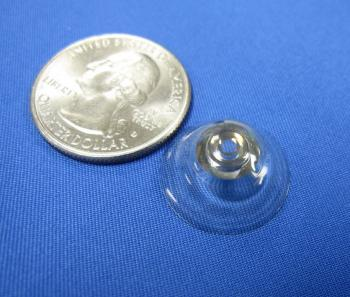As Head Optician at Vision Direct, I like to keep an eye on the latest developments in optical technology. Two significant studies are underway that, if successful, could make a difference to how we treat eye infections and age-related macular degeneration (AMD) in the future.
Telescopic contact lenses allow you to zoom in with a wink
Optics specialist Eric Tremblay from the Ecole Polythecnique Federale de lausanne in Switzerland has developed a special telescopic contact lens that lets you magnify detail by winking with your right eye, or wink with your left eye for normal vision.
This futuristic-sounding contact lens could make a significant difference to quality of vision for those who suffer from low vision and age-related macular degeneration (AMD), by allowing them to switch between normal and magnified vision. This is possible because the 1.5mm thick lens contains a very thin, reflective telescope and small mirrors; which bounce light around and expand perceived size of objects, creating an effect that is similar to looking through low-magnification binoculars.

Telescopic contact lens UCSD San Diego Jacobs School of Engineering
The telescopic contact lens is constructed using precision-cut plastic, aluminium mirrors and thin, polarising films, held together with biologically safe glues. The lens is kept breathable to ensure a steady supply of oxygen to the eye, thanks to tiny air channels around 0.1mm wide that cover the lens surface.
It is possible to wear these lenses together with glasses that appear to be regular eyewear, but actually have a small light source detector which will recognise winks and ignore blinks, making it possible for the wearer to control magnification "on-demand".
The telescopic contact lens is still at research stage, but there is hope that it could one day become a real option for sufferers from AMD and low vision, once its current rigid scleral lens construction can be upgraded to a soft contact lens and the technology has been fully safety tested.
Why is the telescopic contact lens important?
Age-related macular degeneration is the leading cause of sight loss among older people in the west. As we get older our macula, which is responsible for central vision, grows less effective, and it is common to suffer from either "dry AMD" which develops when a build up of waste products damages the cells of the macula and causes gradual vision loss, or "wet AMD", which is caused by the formation of abnormal blood vessels underneath the macula, which damage its cells.
While AMD is painless and does not affect peripheral vision, it can impact on quality of life, causing you to suffer from blurry vision that prevents you from reading, driving, focusing on screens or even in some cases, recognising people's faces. The current telescopic contact lens is a precursor to more effective, less intrusive treatments that are easier to manage, and could allow AMD sufferers to enjoy comfortable, convenient vision correction in the future.
Dissolving nanowafer contact lenses delivers slow-release eye medicine
Dr. Steven Pflugfelder, professor of opthalmology at Baylor College of Medicine in Dallas, has co-authored a study into dissolving nanowafer contact lenses, which could be used to dispense slow-release medicines to the eye in a much more effective way than currently available methods.
The nanowafer contact lens is just one-twentieth as thick as a standard contact lens, and is made from a thin resin called polyvinyl alcohol, which contains tiny reservoirs that can be filled with slow-release medicines. The lens can be applied directly to the eye and used to treat eye infections or speed up recovery from burns and damage.
Further studies are underway into whether the nanowafer contact is safe for wide spread medical use, but if it is approved, it could be a very effective way to deliver slow-release medicine to the eye, for up to 24 hours after initial application.
Why is the dissolving nanowafer contact lens important?
This technology could be used to treat a wide variety of eye infections and diseases, including cystinosis, a genetic metabolic disease which is typically diagnosed in young children and causes cystine crystals of amino acid to build up in the cornea and impair vision.
Treating young children and babies using eye drops that have to be applied many times a day can be difficult and ineffective; the dissolving contact lens would only need to be applied once a day and can deliver the essential medicine to treat this condition more effectively.
The future of contact lens technology
As exciting studies and clinical trials continue throughout 2015, I am encouraged to see that the future of contact lens technology includes cutting edge techniques for treating life-altering conditions that could be more effectively managed.
For those of us who are parents to young children or carers for elderly relatives, it is comforting to know that new technologies are being developed which could help us to take care of their eye care needs in a way that is more comfortable and convenient for them.